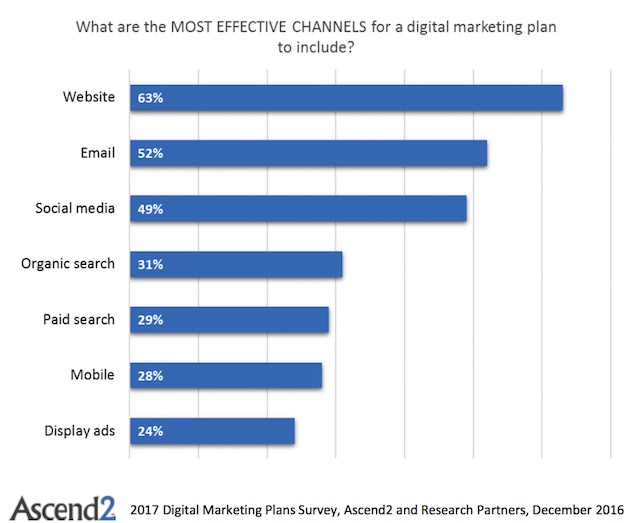It sounds a bit archaic in a world awash in automation and artificial intelligence, but email marketing remains an important and effective component of any digital marketing strategy. In a study by Ascend2 late last year, email placed second, only after a company’s own website, as the most effective marketing strategy.
Some 63 percent of respondents said brand websites are one of the most effective channels to include in a 2017 digital marketing plan; 52 percent said email; 49 percent said social media and 31 percent said organic search.

Chances are, you’re an email marketer and don’t even know it. If you have an applicant tracking system, you’re likely sending out daily email alerts to those who have signed-up to get them. If you post jobs just about anywhere, emails are most definitely going out. And if you have a resume database of interested candidates, you yourself should be sending email messages on a regular basis … employment brand folks, I’m lookin’ at you.
Realizing that keeping up with the latest data around email marketing isn’t likely on the radar for most readers — even though it probably should — I’m going to break down some recent data collected by GetResponse, a popular email marketing solution. My hope is this will serve as a basic level of understanding for the casual marketer that lives in every recruiter.
- Europeans and Australians are most likely to open your message. Both areas have an open rate of about 28 percent. North Americans, in contrast, open messages at a clip of about 20 percent. Only Africa is lower at 17.2 percent. Blame AOL. Europeans also have the highest click-thru rates at nearly 5 percent.
- Open rates by industry varies. Email marketing in the employment is space challenging. Once someone has a job, do they really still care about new opportunities in their inbox? Although the study doesn’t highlight job search, it does include automotive, which may most resemble employment, at a 16.05 percent open rate. “Everyone likes to peek at a beautiful new car now and then, but how often do you buy one?,” said Mateusz Ruzik, customer education team manager at GetResponse.
- Bigger isn’t necessarily better. The study found that smaller lists tend to have much higher open rates and click-thru rates. Email list sizes between 1,000 – 2,499 subscribers enjoyed a 31.19 percent open rate and a 5.22 percent click-thru rate, while lists of a million or more lagged behind with an 8.15 percent open rate and 1.59 percent click-thru rate.
- Time of day matters. The highest open rates occur at 4 p.m., at 25.13 percent. The lowest open rates happen with messages sent at 2 a.m. with a 13.56 percent open rate. Click-thru rates don’t change much, no matter what time a message is sent. In short, if you send your messages from 9 to 11 a.m. or from 3 to 5 p.m., you’ll get the highest open and click-through rates. Think beginning of the work day or the end when mapping your strategy, which actually works well for employment messages, because people are either going to a job they hate or leaving it during those windows of time.
- Thursday is the best day to push Send. At an open rate of 23.13 percent, Thursday is the best day to send a message. However, the other days of the work week all come in about the same percentage. Saturday and Sunday, not surprisingly, are less effective, both at under 20 percent.
- Frequency matters. The more messages you send, the less effective they become. On a weekly basis, organizations only sending out one message enjoyed a 37.08 percent open rate and a 5.58 percent click-thru rate. the numbers go down gradually the more messages you send, but once you get past five, the open rates dive below 20 percent. Those sending 14 messages a week dropped below 10 percent. Rule of thumb is minimum once a month, maximum once a day.
- Get hip to embedded videos now. “The use of embedded videos in emails is not a common practice yet. The reason? Technology,” said Ruzik. “As of today, only a couple of Internet service providers are compatible with this functionality. Therefore, it is much more common to use animated GIFs or thumbnails linking to the video.” Emails with YouTube video or animated GIFs enjoyed open rates of 31.90 percent.
- Subject line length matters. Longer is usually better. Email messages with 210-219 characters had the highest open rates at 30.62 percent. Messages with subject lines of up to 249 characters had similar numbers. Subject lines between 10-19 characters had a 20.21 percent open rate. Lesson is be descriptive and stop being cute or cryptic.
- Emojis in subject lines actually help. Believe it or not, putting a smiley face or thumbs-up in your subject line can boost your open rates by 2 percent or more. Only 7 percent of messages sent have emojis in the subject line, although I think that’ll start trending as marketers get more comfortable using them. I can see all the job alerts with dollar-sign emojis blasting out now.
- Personalize subject lines for better results. Are people opting in for your messages with a first name? Are you collecting first name in your resume upload process? It matters. Putting someone’s name in the subject line boosts open rates by about 5 percent. Personalization in the actual message helps too, as solutions like Gmail and Outlook show the first part of an email message without actually opening it.
Over at Sourcecon, Marvin Smith has a great series of posts on getting the most out of email if you’re an individual recruiter sending personal messages, and many of the tips above can work on an one-to-one level. However, mass mailings in the form of newsletters or job alerts are a different animal in many aspects, and knowing what those are can be important.
Knowing the strategies that make those mass emails most effective is even more important. With all the buzz about messaging, texting, and Snapchatting, good ol’ fashioned email isn’t going anywhere.
